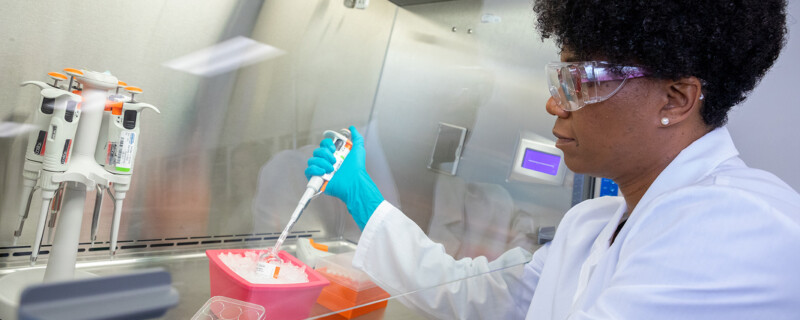
Corning® Matrices and Cultureware Solutions for 3D Cell Culture
While traditional two-dimensional (2D) cell culture has been foundational for in vitro studies, researchers are finding that culturing cells in 3D can better replicate the in vivo microenvironment of tissues and organs, providing a more accurate view of cellular behavior within the body. 3D cell models are increasingly being integrated into research and drug discovery pipelines to bridge the gap between traditional 2D cell cultures and in vivo systems. These models serve as physiologically relevant platforms for more accurate drug screening, target discovery, and personalized medicine approaches.
Scaffold-based and scaffold-free 3D culture are two common approaches used in tissue engineering and cell culture to create 3D cellular models. Scaffold-based 3D culture involves the use of a supportive scaffold material that creates an extracellular matrix-mimicking framework for cells to adhere to, proliferate, and organize into three-dimensional structures. While natural hydrogels like Corning Matrigel® matrix have been the traditional choice, synthetic hydrogels are are an up and coming innovation within the scaffold-based family of products due to their versatility. In contrast, scaffold-free 3D culture encourages cells to self-assemble into 3D structures through cell-cell interactions without the need for external scaffold materials. Hanging drop, Corning Ultra-Low Attachment (ULA) and micropatterned surface cultureware are often used for scaffold-free 3D cell culture.
Corning, a well-established name in cell culture technology, offers an array of natural and synthetic matrices and cultureware that can be used for diverse cell types and 3D cell culture applications in cancer research, toxicology, drug discovery, tissue engineering, personalized medicine and more.
Synthegel® Matrix Kit for Scaffold-based 3D Culture
Synthetic hydrogels, such as the Corning® Synthegel™ 3D matrix, offer a more defined and tunable 3D environment with minimal variability compared to biologic hydrogels. These synthetic matrices are highly versatile, allowing for precise customization to meet the specific growth requirements of a variety of cell types, including cancer and stem cells. Parameters such as peptide composition, hydrogel rigidity, and growth factors can be adjusted to closely mimic the natural microenvironments of a specific cell type for optimal growth.

The Synthegel 3D matrix kits are a critical tool for cancer research, stem cell research, and drug screening conducted in a 3D format. This platform is effective at supporting the culture of cancer spheroids, particularly cell types that don’t naturally form spheroids in a scaffold-free environment. The versatile hydrogel can support the culture of human induced pluripotent stem cells (hiPSCs) in either an embedded or encapsulated format for suspension, which helps enhance culture scalability.
The purified, chemically defined 3D matrix peptide solution is formulated in standard cell culture media at neutral pH and is stable at room temperature. Hydrogel formation is fast and easy to execute—simply mix the peptide solution with the cross-linking reagent and the cell suspension of choice, and the matrix will form within 5-30 minutes with no additional steps required. The hydrogel matrix rigidity is easily tunable by altering the peptide concentration. This streamlined workflow is easily integrated with standard cell culture methodologies, ensuring consistent and reproducible results.
Elplasia® Flasks and Plates for Scaffold-free 3D Culture
There is a growing need for improved techniques that can reproducibly generate bulk quantities of uniformly-sized 3D spheroids for high throughput applications like anti-cancer drug screening. The Corning Elplasia 12K Flask contains 152 microcavities with rounded geometry per cm² within a footprint comparable to a T-75 flask designed to reproducibly generate ~12,000 spheroids of consistent shape and size in a scaffold-free model (Figure 1). The ULA surface of the flasks is a proprietary, animal-free, covalently bonded hydrogel that not only supports spheroid formation but also simplifies the harvesting process, offering researchers a powerful tool for their scaffold-free 3D culture experiments. Additionally, the optically clear, gas permeable polystyrene film is compatible with brightfield and fluorescent microscopy.

Numerous cell lines have been evaluated using the Corning Elplasia 12K flask including:
- Normal cell lines: HEK-293/RFP Human embryonic kidney, HUVEC
- Cancer cell lines: MCF7 Human breast adenocarcinoma, HT-29/GFP Human colon adenocarcinoma, DU-145 Human prostate carcinoma, A549/GFP Human lung carcinoma
- Stem cells: human bone marrow-derived mesenchymal stem cells and hiPSCs
Corning is expanding its range of scaffold-free 3D cultureware using the Elplasia technology with the introduction of the Elplasia 12K open well microplate format. This new addition provides a versatile platform for spheroid generation while providing easy access for sampling and imaging. The open well plate also includes practical features for media exchange, including media ports for streamlined experimentation. Stay tuned for updates on the release of this new product!
Biomimetic 3D cell culture models are being increasingly adopted across many scientific disciplines, offering insights that improve our understanding of complex biological processes and disease mechanisms. Corning’s advanced 3D cell culture technologies including their matrices and Elplasia cultureware provide researchers with the advanced tools and resources needed to drive scientific breakthroughs in oncology, tissue engineering, and therapeutic development with precision and reliability.
To learn more about Corning Elplasia technology click here or to request a sample of the Corning Synthegel 3D matrix kit click here.